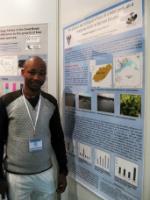
Two Rhodes University postgraduate students, Denham Parker and Phumlile Cotiyane won best student presentation and best student poster respectively, at the recent 15th Southern African Marine Science Symposium (SAMSS) held in Stellenbosch.
Parker is a PhD candidate at the Department of Ichthyology and Fisheries Science and Cotiyane is reading for an MSc in the Department of Botany.
Parker presented a talk entitled ‘Ecology and the problem with space: An evaluation of reef fish in Tsitsikamma Marine Protected Area’ which focused on the advantages and statistical pitfalls, of dealing with spatially autocorrelated data.
Parker’s doctoral research focuses on long-term monitoring (LTM) of coastal marine resources and biodiversity in the Tsitsikamma Marine Protected Area, a project which has been active since 2007 as part of South African Environmental Observations Network’s (SAEON) mandate to monitor marine biodiversity indefinitely. He joined SAEON in 2012 as a student with the aim of optimising the sampling methods associated with LTM programmes in the marine environment.
“The phenomenon of spatial autocorrelation is simply a fact of life for ecologists as organisms are rarely distributed randomly through space, but rather exhibit definitive patterns,” he said, noting that its presence in data does however violate a number of fundamental statistical assumptions, making analyses far more complex, and “often leading to its presence being ignored”.
His presentation reiterated the recent paradigm shift away from viewing spatial autocorrelation as a statistical nuisance to an alternative source of ecological information.
“I believe that LTM programmes are the key to fully understanding ecosystem functioning and ultimately improving management frameworks,” he said, explaining that the monitoring of ecosystems over decades will allow scientist to understand the “bigger picture” such that future predictions will be “mere extensions of observed long-term trends as opposed to over-extended estimations,” he said.
Cotiyane’s poster summarised his Honours research which was titled, “The physical and biological effects of a tidal creek on a mangrove forest at Nahoon Estuary”, and analysed the influence of tidal creeks on mangrove forests and whether occurrences such as the death of mangrove trees were episodic events or part of the natural tidal cycle.
Cotiyane first became interested in estuaries was sparked during her third year when he chose to do a project on mangroves forests which only occur in estuaries. He is a member of the South African Network for Coastal and Oceanic Research (SANCOR) and was encouraged by his supervisor, Dr Anusha Rajkaran to attend and present his research findings in poster form.
“Symposiums like SAMSS present the chance to meet other researchers and future employers. This was the first ever conference I had attended and I learned a lot on top of making contacts,” he said.
On hearing that he had won in her category he said, “I was shocked and did not really expect to win given the fact that so many students from all over the country also presented their work.”
For Parker, winning also came as “a great surprise”. “Initially I thought the topic of my presentation was very specific and would not appeal to the wider audience that SAMSS attracts, but the response I received was amazing, particularly from fellow students who were dealing with similar issues in making sense of complex ecological datasets.”
The symposium provides a forum for interaction, collaboration and exchange of information regarding science in the marine and coastal environments on a regional, national and international scale and drew over 400 presentation abstracts, ranging in topics from seabirds to marine geology.
This year’s theme was ‘Waves of Change – a Southern African Perspective’ which highlighted today’s rapidly changing world, and emphasised the need to understand marine ecosystem’s natural states, the processes that regulate them and the drivers that may be doing irreparable damage.
By Sarah-Jane Bradfield
Photo: Phumlile Cotiyane
